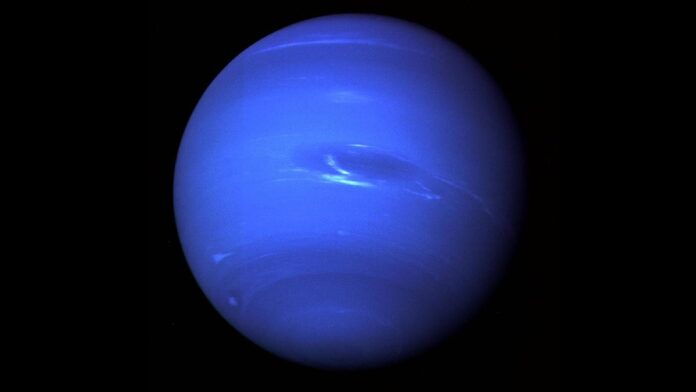Neptune, an ice giant named after the Roman god of the sea, remains one of the most mysterious planets in our Solar System. Discovered in 1846, Neptune is difficult to study due to its great distance from Earth. This planet, with its striking blue color and extreme cold, holds many surprises. The facts gathered so far about Neptune will intrigue both amateur astronomers and professionals alike.
- Mathematically Predicted: Neptune is the first planet whose existence was predicted mathematically before it was directly observed through a telescope. Co-discoverers include John Couch Adams and Urbain Le Verrier.
- The Most Distant Planet: Neptune is the eighth planet from the Sun and the most distant in our Solar System since Pluto was reclassified as a dwarf planet in 2006. It cannot be seen with the naked eye.
- Galileo’s Mistake: In 1612, Galileo Galilei observed Neptune but mistook it for a star due to the limitations of his telescope.
- Planetary Migration: Scientists believe that Neptune originally formed much closer to the Sun, but gravitational interactions, likely with Jupiter or Saturn, moved it to its current position 4.5 billion kilometers (2.8 billion miles) away.
- Density Champion: Neptune is smaller in size than Jupiter, Saturn, and Uranus, but it is the densest of the gas giants.
- Length of a Day and Year: A day on Neptune lasts approximately 16 Earth hours, while a year on Neptune is about 165 Earth years (roughly 60,190 Earth days).
- Mass and Gravity: Neptune is 17 times the mass of Earth and about 4 times larger. However, its surface gravity is only about 17% stronger than Earth’s due to its gaseous composition.
- Structure: Neptune has a rocky core surrounded by a mantle of water, ammonia, and methane ice, with an outer atmosphere primarily composed of hydrogen, helium, and methane. The intense pressure near the surface turns gases into ice crystals.
- Intense Pressure: Although Neptune’s core reaches temperatures of up to 5,000°C (9,000°F), the icy mantle remains solid due to the immense pressure inside the planet.
- Coldest Planet: Neptune is the coldest planet in the Solar System, with atmospheric temperatures dropping as low as -214°C (-353°F).
- Blue Color Mystery: The beautiful deep blue color of Neptune is believed to be caused by methane in its atmosphere, which absorbs red light. However, the exact reason for the color’s intensity is still not fully understood.
- Neptune’s Rings: Neptune has five faint rings, composed of ice particles, dust, and possibly fragments of one of its moons. These rings are faint and fragmented compared to those of Saturn.
- Ring Discovery: The brightest arc of Neptune’s rings was detected in 1989 by Voyager 2, not 1984 as previously thought.
- Extreme Winds: Neptune experiences some of the fastest winds in the Solar System, reaching speeds of up to 2,100 km/h (1,300 mph). The cold reduces friction, allowing the atmosphere to churn at incredible speeds.
- Internal Heat: Despite being so far from the Sun, Neptune generates more than twice the heat it receives from the Sun, possibly due to the slow release of gravitational energy.
- Voyager 2 Flyby: In 1989, NASA’s Voyager 2 spacecraft conducted the first and only close flyby of Neptune, capturing detailed images of its atmosphere, rings, and moons.
- “Rivers” on Neptune: Voyager 2 images revealed that Neptune has dynamic and swirling storms, but descriptions of “rivers” are likely a misinterpretation of cloud and storm formations in its atmosphere.
- Elliptical Orbit: Neptune follows an elliptical orbit around the Sun, causing its distance from the Sun to vary during its long journey.
- Opposite Rotations: Neptune’s atmosphere rotates at a different speed than its core, a phenomenon observed with its cloud movements.
- Dark Spots: Mysterious dark spots, similar to Jupiter’s Great Red Spot, have been observed on Neptune. These are storm systems, but unlike Jupiter’s, they disappear after a few years.
- Hot Spot: Neptune has a “hot spot” near its south pole where the temperature is about 10°C (18°F) higher than the surrounding regions. This causes methane gas to evaporate into the atmosphere.
- Water Presence: Scientists believe Neptune may have vast quantities of water in different states (gaseous, liquid, or supercritical) beneath its thick clouds and icy mantle.
- Neptune’s Moons: Neptune has 14 known moons. Triton, the largest, has a retrograde orbit and is geologically active, with cryovolcanoes that erupt water, ammonia, and nitrogen. Triton is thought to be a captured Kuiper Belt object.
- Triton’s Fate: Triton’s orbit is gradually decaying, and in about 3.6 billion years, it is predicted to collide with Neptune, likely forming a new ring system before disintegrating in Neptune’s atmosphere.
- Postponed Mission: NASA planned a Neptune Orbiter mission to study the planet in greater detail, but it was postponed indefinitely in favor of the Uranus Orbiter and Probe mission, which may launch in the 2030s.
